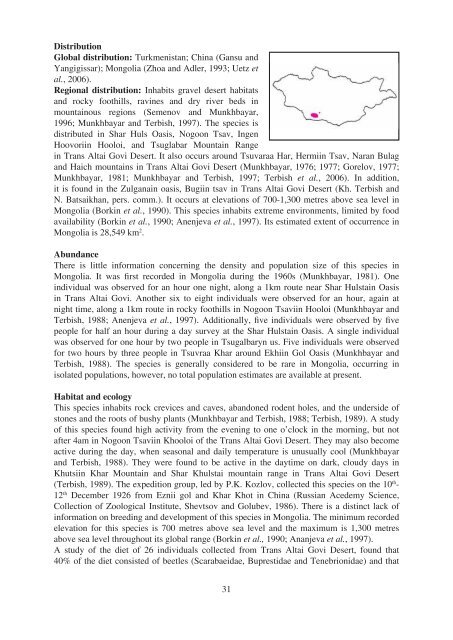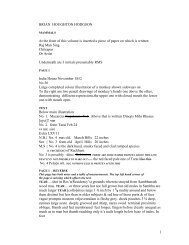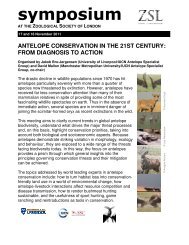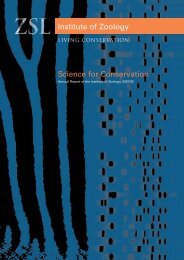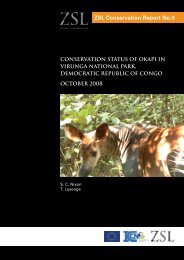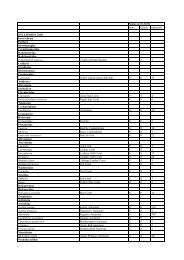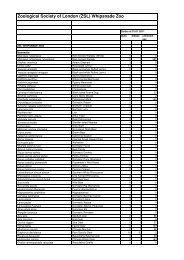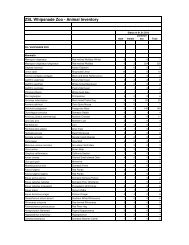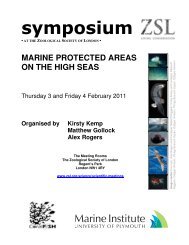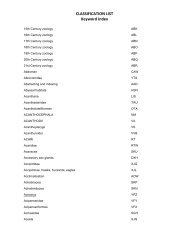Summary Conservation Action Plans for Mongolian Reptiles and ...
Summary Conservation Action Plans for Mongolian Reptiles and ...
Summary Conservation Action Plans for Mongolian Reptiles and ...
You also want an ePaper? Increase the reach of your titles
YUMPU automatically turns print PDFs into web optimized ePapers that Google loves.
Distribution<br />
Global distribution: Turkmenistan; China (Gansu <strong>and</strong><br />
Yangigissar); Mongolia (Zhoa <strong>and</strong> Adler, 1993; Uetz et<br />
al., 2006).<br />
Regional distribution: Inhabits gravel desert habitats<br />
<strong>and</strong> rocky foothills, ravines <strong>and</strong> dry river beds in<br />
mountainous regions (Semenov <strong>and</strong> Munkhbayar,<br />
1996; Munkhbayar <strong>and</strong> Terbish, 1997). The species is<br />
distributed in Shar Huls Oasis, Nogoon Tsav, Ingen<br />
Hoovoriin Hooloi, <strong>and</strong> Tsuglabar Mountain Range<br />
in Trans Altai Govi Desert. It also occurs around Tsuvaraa Har, Hermiin Tsav, Naran Bulag<br />
<strong>and</strong> Haich mountains in Trans Altai Govi Desert (Munkhbayar, 1976; 1977; Gorelov, 1977;<br />
Munkhbayar, 1981; Munkhbayar <strong>and</strong> Terbish, 1997; Terbish et al., 2006). In addition,<br />
it is found in the Zulganain oasis, Bugiin tsav in Trans Altai Govi Desert (Kh. Terbish <strong>and</strong><br />
N. Batsaikhan, pers. comm.). It occurs at elevations of 700-1,300 metres above sea level in<br />
Mongolia (Borkin et al., 1990). This species inhabits extreme environments, limited by food<br />
availability (Borkin et al., 1990; Anenjeva et al., 1997). Its estimated extent of occurrence in<br />
Mongolia is 28,549 km 2 .<br />
Abundance<br />
There is little in<strong>for</strong>mation concerning the density <strong>and</strong> population size of this species in<br />
Mongolia. It was fi rst recorded in Mongolia during the 1960s (Munkhbayar, 1981). One<br />
individual was observed <strong>for</strong> an hour one night, along a 1km route near Shar Hulstain Oasis<br />
in Trans Altai Govi. Another six to eight individuals were observed <strong>for</strong> an hour, again at<br />
night time, along a 1km route in rocky foothills in Nogoon Tsaviin Hooloi (Munkhbayar <strong>and</strong><br />
Terbish, 1988; Anenjeva et al., 1997). Additionally, fi ve individuals were observed by fi ve<br />
people <strong>for</strong> half an hour during a day survey at the Shar Hulstain Oasis. A single individual<br />
was observed <strong>for</strong> one hour by two people in Tsugalbaryn us. Five individuals were observed<br />
<strong>for</strong> two hours by three people in Tsuvraa Khar around Ekhiin Gol Oasis (Munkhbayar <strong>and</strong><br />
Terbish, 1988). The species is generally considered to be rare in Mongolia, occurring in<br />
isolated populations, however, no total population estimates are available at present.<br />
Habitat <strong>and</strong> ecology<br />
This species inhabits rock crevices <strong>and</strong> caves, ab<strong>and</strong>oned rodent holes, <strong>and</strong> the underside of<br />
stones <strong>and</strong> the roots of bushy plants (Munkhbayar <strong>and</strong> Terbish, 1988; Terbish, 1989). A study<br />
of this species found high activity from the evening to one o’clock in the morning, but not<br />
after 4am in Nogoon Tsaviin Khooloi of the Trans Altai Govi Desert. They may also become<br />
active during the day, when seasonal <strong>and</strong> daily temperature is unusually cool (Munkhbayar<br />
<strong>and</strong> Terbish, 1988). They were found to be active in the daytime on dark, cloudy days in<br />
Khutsiin Khar Mountain <strong>and</strong> Shar Khulstai mountain range in Trans Altai Govi Desert<br />
(Terbish, 1989). The expedition group, led by P.K. Kozlov, collected this species on the 10 th -<br />
12 th December 1926 from Eznii gol <strong>and</strong> Khar Khot in China (Russian Acedemy Science,<br />
Collection of Zoological Institute, Shevtsov <strong>and</strong> Golubev, 1986). There is a distinct lack of<br />
in<strong>for</strong>mation on breeding <strong>and</strong> development of this species in Mongolia. The minimum recorded<br />
elevation <strong>for</strong> this species is 700 metres above sea level <strong>and</strong> the maximum is 1,300 metres<br />
above sea level throughout its global range (Borkin et al., 1990; Ananjeva et al., 1997).<br />
A study of the diet of 26 individuals collected from Trans Altai Govi Desert, found that<br />
40% of the diet consisted of beetles (Scarabaeidae, Buprestidae <strong>and</strong> Tenebrionidae) <strong>and</strong> that<br />
31


